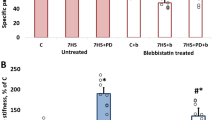Abstract
Soleus muscle atrophy was induced by hindlimb suspension of rats for 3 weeks with the intention of inducing a relative increase in the percentage of fast twitch fibres and assessing modifications in muscle stiffness. A method of dual controlled releases was used to obtain tension/extension curves and force/velocity relationships characterizing the mechanical behaviour of the soleus. Fibre typing was achieved by myofibrillar adenosine 5′-triphosphatase staining. Results showed that hindlimb suspension decreased the percentage of slowtwitch fibres (−31%) to the profit of fast-twitch fibres (+370%) and intermediate fibres (+255%). This led to an increase in maximal shortening velocity. Tension/extension curves indicated a decrease in soleus stiffness after 3 weeks of unloading. Changes in elastic properties are interpreted in terms of modifications occurring in the active part and the passive part of the so-called series elastic component. These changes also suggest that the parameters derived from a twitch are inappropriate to account for modifications in speed-related properties of muscle.
Similar content being viewed by others
References
Asmussen G, Miersch H, Soukup T (1989) The influence of suspension hypokinesia on contractile properties of slow and fast muscles of young growing and adult rats. Biomed Biochim Acta 48:S426-S431
Beckers-Bleukx G, Maréchal G (1989) Force-velocity relation and myosin isozymes of rat muscles. Biomed Biochim Acta 48:S412-S416
Bosco C, Tihanyi J, Komi PV, Fekete G, Apor P (1982) Store and recoil of elastic energy in slow and fast types of human skeletal muscles. Acta Physiol Scand 116:343–349
Brooke MH, Kaiser KK (1970) Muscle fiber types: how many and what kind? Arch Neurol 23:369–379
Darr KC, Schultz E (1989) Hindlimb suspension suppresses muscle growth and satellite cell proliferation. J Appl Physiol 67:1827–1834
Desplanches D, Mayet MH, Sempore B, Flandrois R (1987) Structural and functional response to prolonged hindlimb suspension in rat muscle. J Appl Physiol 63:558–563
Diffee GM, Caizzo VJ, Herrick RE, Baldwin KM (1991) Contractile and biochemical properties of rat soleus and plantaris after hindlimb suspension. Am J Physiol 260:C528-C534
Eisen A, Karpati G, Carpenter S (1975) Reserpine induced alteration of physiological properties and histochemical fibre types in rat skeletal muscle. Exp Neurol 46:554–565
Elder GCB, McComas AJ (1987) Development of rat muscle during short — and long — term hindlimb suspension. J Appl Physiol 62:1917–1923
Fitts RH, Metzer JM, Riley DA, Unsworth BR (1986) Models of disuse: a comparison of hindlimb suspension and immobilization. J Appl Physiol 60:1946–1953
Gardetto PR, Schulter JM, Fitts RH (1989) Contractile function of single muscle fibers following hindlimb suspension. J Appl Physiol 66:2739–2749
Goubel F, Marini JF (1987) Fiber type transition and stiffness modification of soleus muscle of trained rats. Pflügers Arch 410:321–325
Hill AV (1938) The heat of shortening and the dynamic constants of muscle. Proc R Soc Lond [Biol] 126:136–195
Hill AV (1951) The effect of series compliance on the tension developed in muscle twitch. Proc R Soc Lond [Biol] 138:325–329
Julian FJ, Moss RL, Waller GS (1981) Mechanical properties and myosin light chain composition of skinned muscle fibers from adult and new-born rabbits. J Physiol (Lond) 311:211–218
Kawai M, Schacht FH (1984) Differences in the transient response of fast and slow skeletal muscle fibers. Biophys J 45:1145–1151
Lensel-Corbeil G, Goubel F (1989) Series elasticity in frog sartorius muscle during release and stretch. Arch Int Physiol Biochim 97:499–509
Morey ER (1979) Spaceflight and bone turnover: correlation with a new rat model of weightlessness. Bioscience 29:168–172
Nakagawa Y, Totsuka M, Sato T, Hirota K (1989) Effect of disuse on the ultrastructure of the achilles tendon in rats. Eur J Appl Physiol 59:239–242
Petit J, Filippi GM, Emonet-Denand F, Hunt CC, Laporte Y (1990) Changes in muscle stiffness produced by motor unit of different types in peroneus longus muscle of cat. J Neurophysiol 63:190–197
Pierotti DJ, Roy RR, Flores V, Edgerton VR (1990) Influence of 7 days of hindlimb suspension and intermittent weight support on rat muscle mechanical properties. Aviat Space Environ Med 61:205–210
Pousson M, Pérot C, Goubel F (1991) Stiffness changes and fiber type transitions in rat soleus muscle produced by jumping training Pflügers Arch 419:127–130
Reiser PJ, Moss RL, Guilian GG, Greaser ML (1985) Shortening velocity in single fibers from adult rabbit soleus muscles in correlated with myosin heavy chain composition. J Biol Chem 260:9077–9080
Stevens ED, Renaud JM (1985) Use of dP/dt and rise time to estimate speed of shortening in muscle. Am J Physiol 249:R510-R513
Stevens L, Mounier Y (1992) Ca2+ movements in sarcoplasmic reticulum of rat soleus fibers after hindlimb suspension. J Appl Physiol 2:1735–1740
Templeton GH, Padalino M, Manton J, Glasberg M, Silver CJ, Silver P, Demartino G, Leconey T, Klug G, Hagler H, Sutko JC (1984) Influence of suspension hypokinesia on rat soleus muscle. J Appl Physiol 56:278–286
Templeton GH, Sweeney HL, Timson BF, Padalino M, Dudenhoeffer GA (1988) Changes in fiber composition of soleus muscle during hindlimb suspension. J Appl Physiol 65:1191–1195
Thomason DB, Booth FW, (1990) Atrophy of the soleus muscle by hindlimb unweighting. J Appl Physiol 68:1–12
Vailas AC, Deluna DM, Lewis LL, Curwin SL, Roy RR, Alford EK (1988) Adaptation of bone and tendon to prolonged hindlimb suspension in rats. J Appl Physiol 65:373–376
Winiarski AM, Roy RR, Alford EK, Chiang PC, Edgerton VR (1987) Mechanical properties of rat skeletal muscle after hindlimb suspension. Exp Neurol 96:650–660
Woledge RC, Curtin NA, Homsher E (1985) Energetic aspects of muscle contraction. Academic, London
Author information
Authors and Affiliations
Rights and permissions
About this article
Cite this article
Canon, F., Goubel, F. Changes in stiffness induced by hindlimb suspension in rat soleus muscle. Pflugers Arch. 429, 332–337 (1995). https://doi.org/10.1007/BF00374147
Received:
Revised:
Accepted:
Issue Date:
DOI: https://doi.org/10.1007/BF00374147




